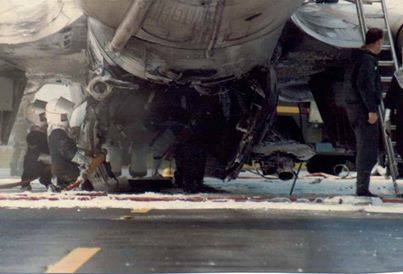Nimrod XV257 – Its final flight with a RAF crew on board.
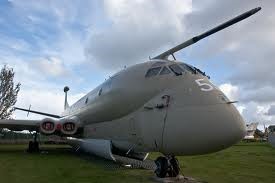
“SAREX 51, mayday! mayday! mayday! fire in the bomb bay.…..”
It was during an exercise at RAF St Mawgan on a summer’s day in 1984 that a Nimrod of 42 Squadron suffered the most serious emergency yet encountered with this aircraft type. At 1040 SAC Barry Wallond, an Assistant Air Traffic Controller slid behind the wheel of his Land Rover and commenced an airfield inspection. His main objective was to check therunway for birds and Foreign Object Debris (FOD), to do this properly; he was exercise exempt and did not need to wear the dreaded respirator. “I was protecting the take-off of a Nimrod which was now moving along the southern taxiway. The weather was fine but we’d had recent rain and although the runway was damp, some areas of grass were water-logged and quite muddy. Due to the size of the runway (9,000ft long and 300ft wide) it required at least three runs to do it justice and by the third run, my Nimrod was already entering the runway and lining up. I simply drove off the far end into the overshoot and called vacated. I positioned the vehicle in a way that I could watch the take-off roll with binoculars, this was a scramble, already she was powering up – I could see the smoke! A few seconds later, nearly two miles away I was staring through the bino’s at a Nimrod head-on, racing over St Mawgan’s famous hump straight at me. At about the halfway point the nose wheel left the ground followed shortly by the main gear, the time was 1100:10, she climbed fairly quickly and soon tucked up her undercarriage and flaps. I lost interest as she passed over the top out of view, distracted with other things going on across the airfield.
It was believed that she was already doomed, probably during the take-off roll or shortly after.”
This particular Nimrod MR2 (XV257) was configured as a Search and Rescue (SAR) standby for the Tactical Evaluation (TACEVAL) and as such was loaded with air-sea rescue equipment. A part of the load was 18 five inch illumination flares mounted on carriers at the rear of the bomb bay. These flares are made of magnesium and burn at a temperature in excess of 2,000°C to emit at least 13 million candle power for around 3 minutes. It was one of these flares that had during take-off become detached and dropped onto the closed bomb bay doors. As the aircraft left the circuit the Captain ordered ‘SAR checks outbound’ and with this the Navigator dutifully selected fusing for nose and tail on the flares. Within a few seconds deep in the belly of XV257 – it ignited.
1102:40
Bomb bay fire alarm bell activates.
Captain: We have an ….. Underfloor warning test of the bomb bay. Can we have a look at the bomb bay please?
1102:46
AEO: Certainly (Air Electronics Officer)
1102:47
Captain: Bomb bay fire warning – turn back please.
1102:50
Flt Eng: Bomb bay heating is off …
Nav 2: You’ve got it [St Mawgan] on the TACAN.
Captain: OK.
1103:00
Captain (To Air Traffic): SAREX 51 …. (Interrupted by AEO)
AEO: We have a fire in the bomb bay! We have a fire in the bomb bay!
Captain (To Air Traffic): SAREX 51, Mayday, Mayday, Mayday; Fire in the bomb bay – coming back for an immediate landing on runway 13, Mayday, Mayday, Mayday.
1103:20
Air Traffic: SAREX 51 your Mayday acknowledged.
Captain: Push it back fast boys, airbrakes out, let’s get this thing on the ground.
Co-pilot: Yes, coming back, don’t worry.
At a height of 5,000ft, XV257 was put into a tight left turn
Air Traffic: SAREX 51 – steer 080 ….
Wing centre section overheat warning illuminates
AEO: It seems to be confined to the back end …
1103:30
Captain: OK, vacation of the aircraft will be from the front door at the moment so be prepared for a front door exit.
Aileron bay underfloor alarm bell rings
AEO: Front door copied.
1103:40
Flt Eng: Eng copied
Co-pilot: Aileron servo dyne ….
Flt Eng: Contact, break, break ….
Captain: Aileron servo dyne bay ….
Flt Eng: Break, break, centre section drill is complete, aileron underfloor….
AEO: Aileron underfloor copied.
1103:50
Captain: All crew 100 per cent oxygen.
1104:00
Flt Eng: Underfloor warning immediate actions, aileron bay; all crews to both intercoms; smoke detector …. did not reset, bell isolation switches…. are off; crew member to check affected compartment ….
Air Traffic: SAREX 51, approach cable will be up, the circuit is clear, QFE for runway 13 is 986mb.
Flt Eng: Subsequent actions; all crew 100 percent oxygen, smoke goggles are available, avionic cooling fans are …. off, galley master …. off. AEO, Eng, report.
1104:20
Dry 3: AEO’s on ….
AEO: AEO on intercom, unable to get (extinguisher) plugged into aileron bay.
1104:30
Captain (To Air Traffic): Mayday rescue 51 now has an underfloor warning in the aileron servodyne bay as well. There’s no practise about this, sport!
Air Traffic: 51, that’s understood.
1104:50
AEO: (extinguisher is) in the aileron bay, split pin removed. Smoke now entering the fuselage
AEO: Smoke in the fuselage, standing by to fire the fire extinguisher. Total hydraulic system failure (main utility)
Captain (To Air Traffic): We now have smoke in the fuselage, intention’s land, shutdown all engines, vacate starboard front, and for Christ’s sake get everything ready! Bomb bay doors fall full open ejecting (some) burning flares
On the ground Barry was watching the drama unfold before him.
“I was still positioned in the undershoot of 13 and with the next aircraft movement not due for another 45 minutes or so, I had turned down the Storno radio and was taking a well earned break. Within 5 minutes I spotted a Nimrod out to sea going like the clappers passing Newquay north bound. It was not a huge surprise as I had been told some time earlier it was to return with an exercise emergency (!) I turned up the radio and scanned the runway briefly, all in order. However, the radio was a complete babble of agitated and excited voices, it was difficult to understand what was going on until I heard ATC telling Crash Combine (Fire fighting vehicles) of ‘a fire in the bomb bay’, I now turned my attention back to the Nimrod, almost immediately the rear end light-up like a street lamp. Just for the briefest of moments I thought ‘how did they do that?’ I still had exercise on the brain. Then something fell away burning, then something else, a few seconds passed and what appeared to be an explosion near the tail end and several bright burning bits of wreckage fell into the sea (these were in fact the 5 inch flares burning their way out of the aircraft). The bomb doors dropped into the down position at about the same time and the fire extended from the rear of the bomb bay back to an area adjacent to the middle of the fin and rudder.”
1105:00
Co-pilot: Undercarriage is travelling down. What’s the (touchdown) speed for me, Eng? Quick please.
1105:10
Captain: One …..Thirty
Air Traffic: SAREX 51, you have been cleared to land on runway 13, surface wind 270/10.
1105:20
AEO: Eng, AEO, standing by to fire the extinguisher.
Flt Eng: Go ahead.
AEO: First burst going now.
1105:30
Co-pilot (to Captain): OK, check your brakes on the red (hydraulic system)
Captain (to Air Traffic): Mayday 51 …
Captain: Brakes are on red …. checking…..
Co-pilot: Checking ….
AEO: First burst complete, Eng.
Flt Eng: Eng copied. Undercarriage has failed to lower
Co-pilot: We haven’t got any undercarriage coming down. We’ve got an undercarriage stuck up.
Captain: Oh, Christ! Undercarriage to red, please … undercarriage to red selection.
Flt Eng: Red ….
Captain: Red pump on.
Co-pilot: There we are ….
Captain: Red selected ….two greens …
Fire warning alarms for number 2 engine
Captain: Fire in number 2 engine, zone 2 … shutting down number 2 engine … HP cock off … LP cock shut ….
Flt Eng: 1 and 2 HP air supply levers are off.
1106:00
Captain: Firing first shot …
Co-pilot: OK, I’m landing ……
Captain (to Air Traffic): OK, landing off this, we’ve now got a fire indication in number 2 engine….There’ a real fire in the bomb bay as far as we can see.
ATC: SAREX 51.
AEO: Second shot going, the aileron bay is full of smoke.
1106:10
Flt Eng: Eng copied
AEO: Strap in! Strap in!
Captain: Brace! Brace! Brace!
Barry continues, “She rolled out onto finals for runway 13, dragging her banner of fire and smoke across the sky. For the second time in just a few minutes she was again heading … straight at me! I couldn’t take my eyes off her, as I fumbled for the keys, I saw she had no gear (undercarriage), at less than 300ft it seemed to flop down, I never did get out of the way properly and for a brief moment my world slowed down as she flew over my Land rover at about 80ft, by now the flames were beyond the MAD boom, a distance of over 40ft and the Clamshell door behind the bomb bay doors had also fallen open; it was a bloody miracle she was still flying. The roar of the engines and the flames was deafening as she passed over the top and numerous bits of burning aluminium fell all around me.
The landing in the circumstance was quite superb, I think the last of the flares fell on touchdown out at 130kts and skated several hundred feet down the runway in a most spectacular manner.”
1106:20
Aircraft lands
Co-pilot: OK, reversers in now, please.
Captain: In, running up.
1106:30
AEO: Front exit when the aircraft stops …
Co-pilot: Check brakes, Gordon.
Captain: You have no pressure at the moment … brakes onto red.
Co-pilot: Red, please.
Captain: You have red … Checking brakes, no maxarets, 600 (psi) both sides …
1106:40
Flt Eng: Total green system failure, total green system failure.
Captain: No, brakes are working …
Co-pilot: We’re on the red … reverse idle.
1106:50
Captain: Reverse idle.
Co-pilot: Turning off next exit on right
Captain: OK, Oh … kay.
Flt Eng: Fire second shot into number 2 engine.
Captain: It’s out
Flt Eng: OK.
1107:00
Underfloor fire warning alarm in elevator servo-dyne bay activates.
Captain: The underfloor (fire) has moved to the elevator bay as expected – flow
AEO: AEO copied.
Co-pilot: We’ll stop here.
Captain: OK, everybody out, everybody out.
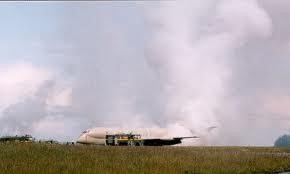
The Co-pilot had used up over 7,500ft to bring the aircraft under control then calmly turned off the runway onto ‘November south’ which let the wind to push the smoke away from the crew egress point and allowed St Mawgan to keep the main runway open for further emergencies. As the aircraft came to a halt the crew threw open the front right hand exit door, deployed the escape rope attached to the roof of the door frame and began to slide down to safety. This was very much a two handed operation and it was noted that one aircrew missed the rope altogether and landed heavily 10 feet below as he was clutching his Nav bag! The Crash crew arrived promptly and fought the flames with much enthusiasm and bravery, saving the aircraft from total destruction. Meanwhile, Barry had extricated his Land rover from the Cornish stone wall that he‘d reversed into moments ago and then chased down the runway after XV257.
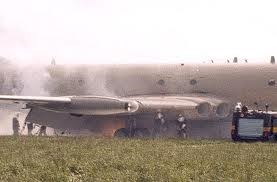
“Normally I would have kept well out of the way of burning aeroplanes but on this occasion I was carrying my camera. I arrived shortly after the Fire engines and took 22 photographs for the records. These are the only known pictures taken of the incident. A few days later I learnt that the seat of the flames where under a 650 gallon fuel tank which had swollen to the point of exploding. If this tank had gone, it would have certainly broken the fuselage in two at the rear of the bomb bay, resulting in a catastrophic failure of the airframe. Against all the odds XV257 made it back to base and landed safely with several different emergencies on-going at the same time, this was in no small part due to the teamwork displayed by the aircrew, the firemen and a touch of ‘lady luck’. An engineering officer told me later that after inspecting the damage ‘forget the fuel tank bursting or the controls severed and inoperable, this aircraft just would not have lasted another 2 minutes without complete structural failure’. To this day, when I see a Nimrod I always look at the bomb bay and think of XV257”
For well over a year she was in 404 hangar undergoing repairs for a one-off flight to BAE Woodford. She was flown there with a volunteer civvy crew, with no bomb bay doors and the undercarriage locked and pinned in the down position.
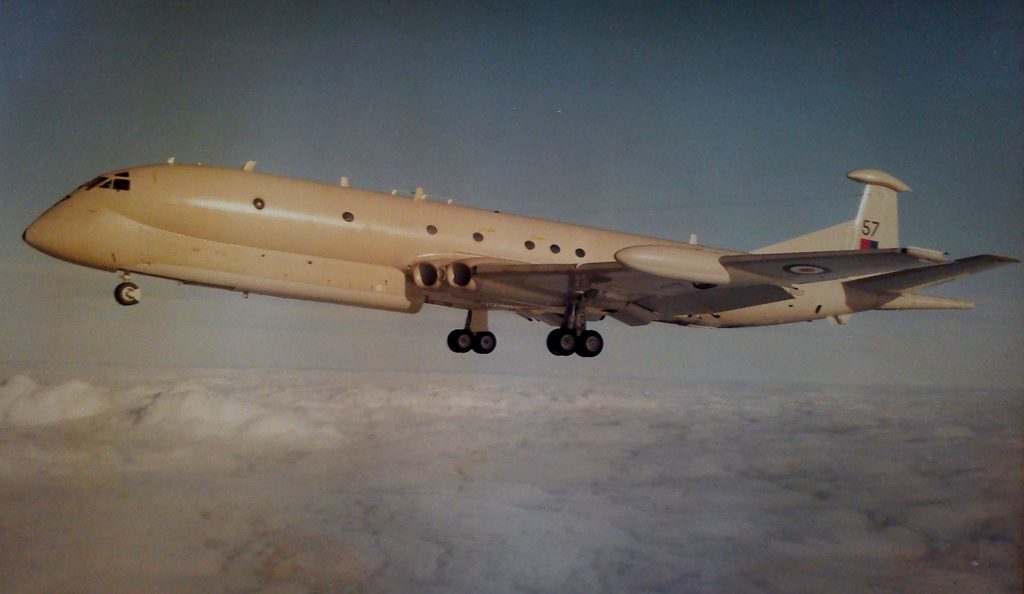
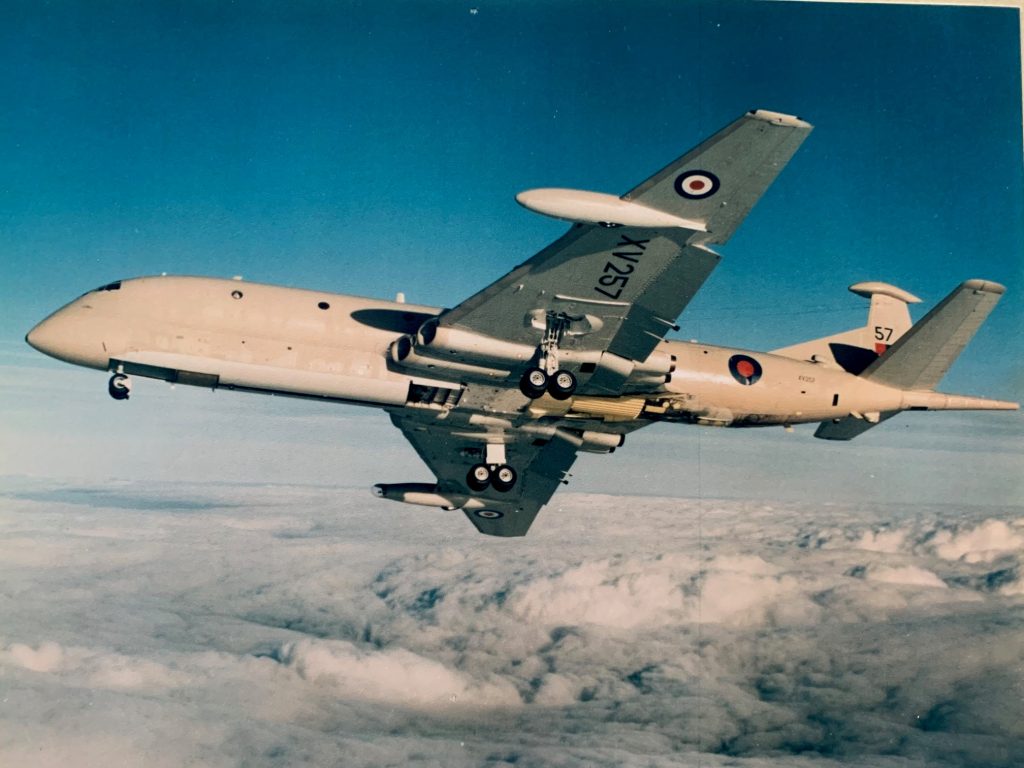
She was to have been rebuilt as an AEW version of the Nimrod and re-enter service 3 years later. Sadly as she was near to completion she was destroyed when the roof of the hangar collapsed during gale force winds.
The Air Engineer on this sortie was ‘Moose’ Moxon, a 22 year old first tourist, who managed to use the experience of this momentous event to ensure a safe and reasonably uneventful career which ended on the 31st August 2012.
None of the crew received any recognition for their actions, though the firemen were congratulated by AOC 18 Group!
